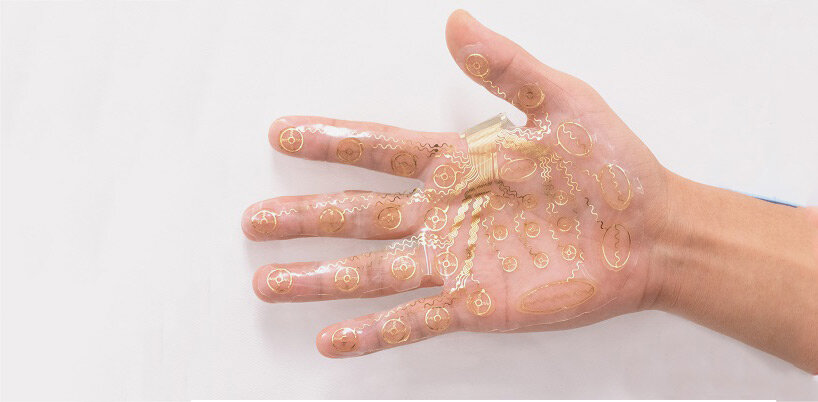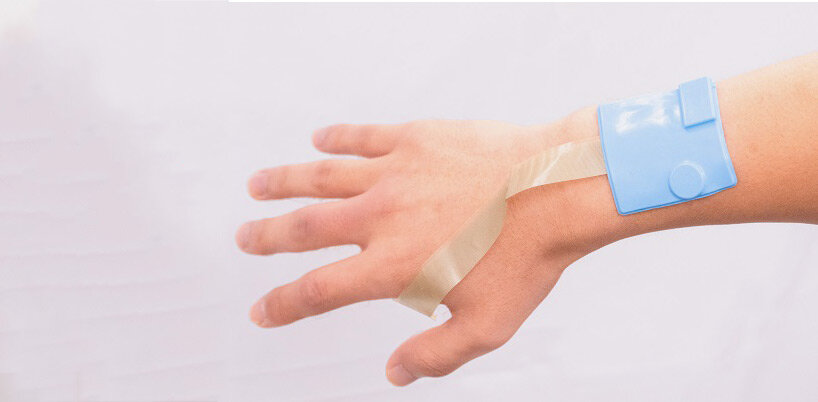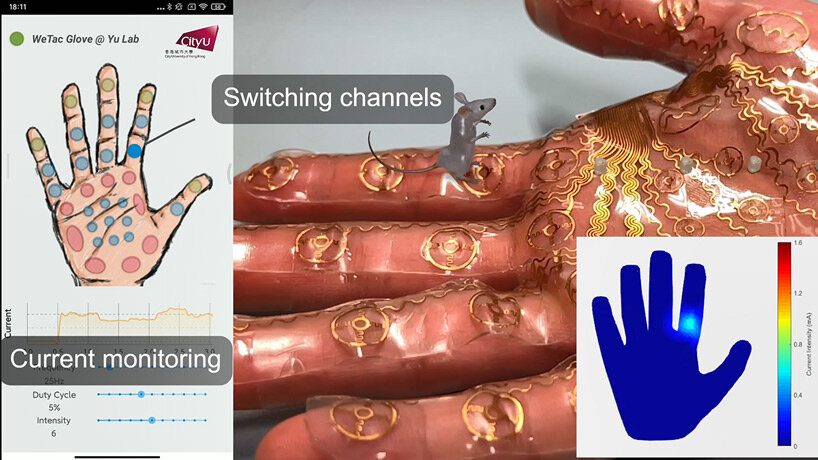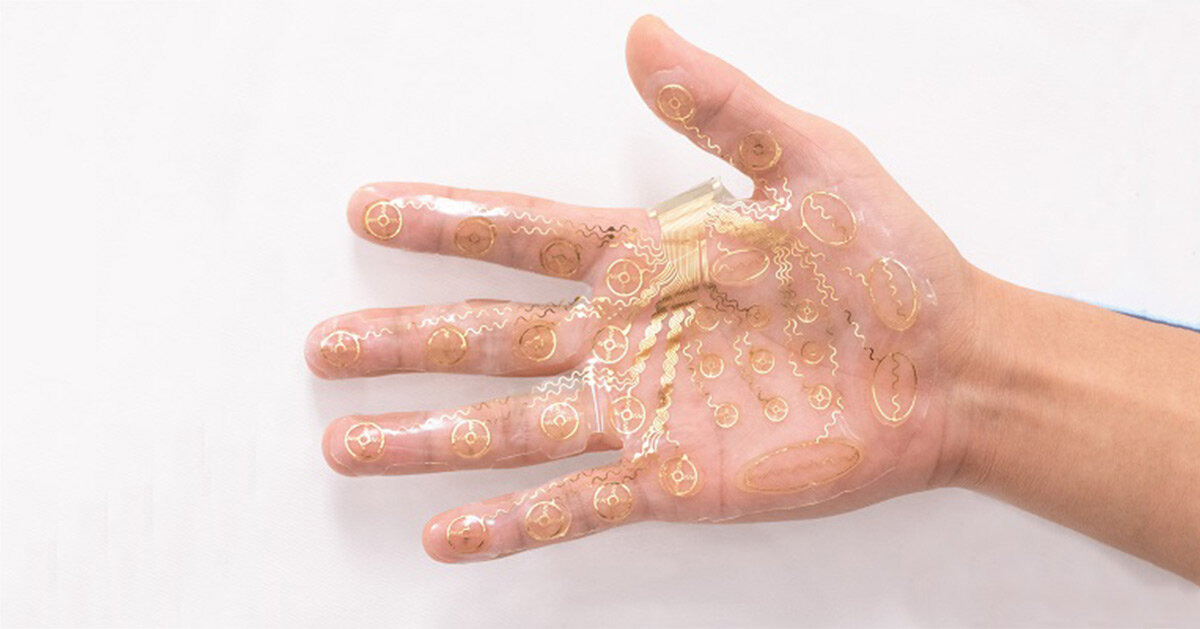‘wetac’ electro-tactile feedback system
A team of researchers at the City University of Hong Kong (CityU) has recently introduced ‘WeTac’, a thin, wearable electronic ‘skin’ that provides tactile feedback to users in VR and AR environments. This wireless electro-tactile system is made of a skin-friendly hydrogel layer that sticks onto the users’ palms and collects their personalized tactile sensing data, hoping to bring a more realistic and vivid virtual touch experience to the Metaverse. The newly developed innovation has great application potential in virtual games, sports, technical training, social interaction, or remote control robots.
‘In addition to vision and hearing, tactile feedback will further enhance the experience of virtual reality (VR). Therefore, we are committed to developing a wireless tactile interface that is thinner, softer, and more skin-friendly, and the user can still move freely when wearing it in hand, just like a second skin.’ shares Dr Yu Xinge, Associate Professor of the Department of Biomedical Engineering at CityU and leader of the research.

the WeTac system consists of a thin skin-friendly palm patch | all images courtesy of the City University of Hong Kong (CityU)
wireless wearable palm patches replace bulky tactile gloves
Tactile gloves currently on the market consist mainly of air pumps and air ducts, as well as control systems powered by wires and cables, which significantly compromise users’ immersive experience in virtual and augmented reality. In contrast to these bulky gloves, the newly developed WeTac, is thin, soft, and skin-friendly, thus providing a better user experience.
The WeTac system developed by CityU (find more here) consists of two parts: a tiny flexible actuator that serves as a control panel, and a palm patch with hydrogel electrodes as a tactile interface. The entire actuator weighs only 19.2 grams and is small enough (5 cm x 5 cm x 2.1 mm) to be worn on the user’s forearm. It is also equipped with Bluetooth Low Energy (BLE) and a small rechargeable lithium-ion battery used for wireless transmission and power. The thickness of the palm patch is only 220 microns to 1 mm. The electrodes extend from the palm to the fingertips.

the flexible actuator is attached to the user’s forearm
Potential for a wide range of applications
The WeTac system has been successfully integrated into virtual scenes such as VR and AR and can also work along devices like robotic arms via BLE communication. Its lightweight, portable, and wireless control design and sensitivity-based intensity adjustment allow users to easily experience virtual touch with ‘hands and feet.’ Users can experience virtual objects in different scenarios, such as grasping a tennis ball during sports practice, touching a cactus in virtual social networks or games, or feeling a mouse walking on their hands.
‘The team believes that this research can provide an effective development tool for virtual contact, and also bring enlightening significance to the development of ‘Metaverse’, human-machine interface operation and other different fields of technology.’ says Dr. Yu.

project info:
name: WeTac
author: City University of Hong Kong (CityU)
myrto katsikopoulou I designboom
dec 19, 2022
Read More: news.google.com









 Bitcoin
Bitcoin  Ethereum
Ethereum  Tether
Tether  XRP
XRP  Solana
Solana  USDC
USDC  Dogecoin
Dogecoin  Cardano
Cardano  TRON
TRON  Lido Staked Ether
Lido Staked Ether  Wrapped Bitcoin
Wrapped Bitcoin  Sui
Sui  Chainlink
Chainlink  Avalanche
Avalanche  Stellar
Stellar  LEO Token
LEO Token  Shiba Inu
Shiba Inu  Toncoin
Toncoin  Hedera
Hedera  Wrapped stETH
Wrapped stETH  USDS
USDS  Bitcoin Cash
Bitcoin Cash  Polkadot
Polkadot  Litecoin
Litecoin  Hyperliquid
Hyperliquid  Bitget Token
Bitget Token  Binance Bridged USDT (BNB Smart Chain)
Binance Bridged USDT (BNB Smart Chain)  WETH
WETH  Ethena USDe
Ethena USDe  Pi Network
Pi Network  Monero
Monero  WhiteBIT Coin
WhiteBIT Coin  Wrapped eETH
Wrapped eETH  Coinbase Wrapped BTC
Coinbase Wrapped BTC  Pepe
Pepe  Uniswap
Uniswap  Aptos
Aptos  Dai
Dai  Ondo
Ondo  OKB
OKB  NEAR Protocol
NEAR Protocol  Bittensor
Bittensor  Gate
Gate  Internet Computer
Internet Computer  Official Trump
Official Trump  Ethereum Classic
Ethereum Classic  sUSDS
sUSDS  Tokenize Xchange
Tokenize Xchange